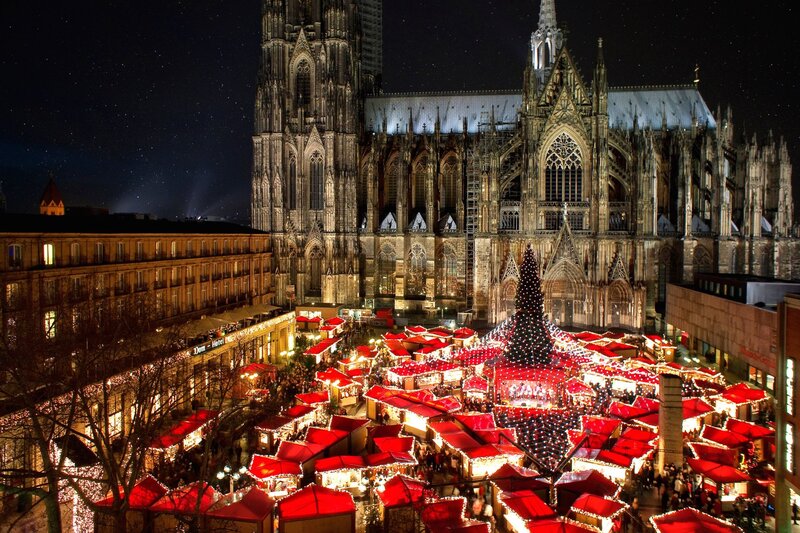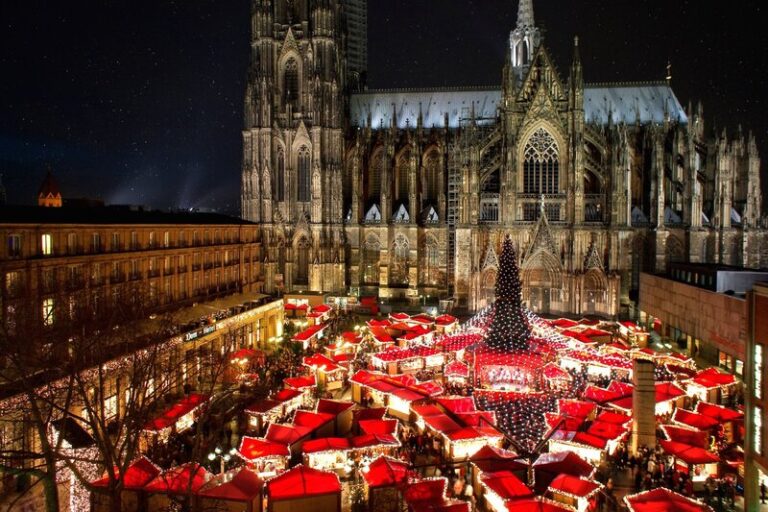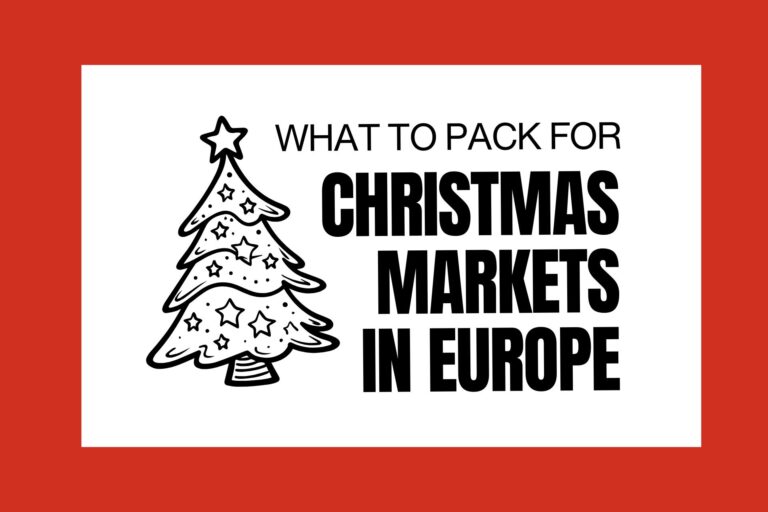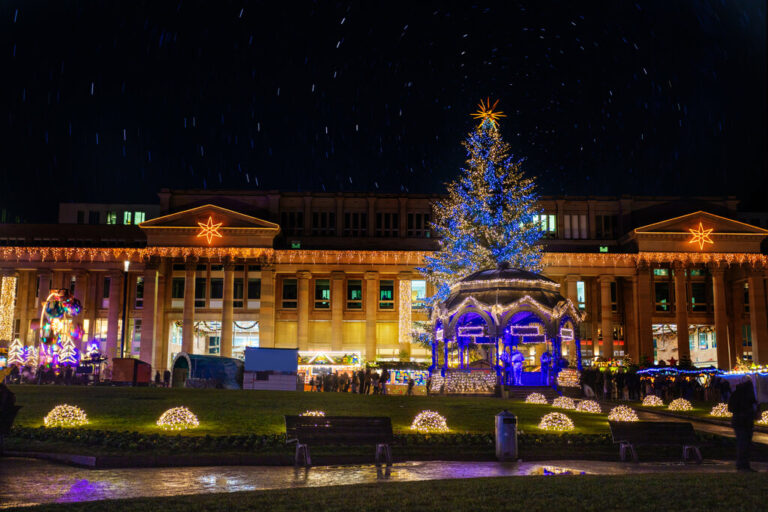Best Christmas Markets in Germany (2025 Guide)
Germany is where Christmas markets began — and no matter how many festive spots you visit in Europe, there’s something extra special about celebrating the season here.
From fairytale towns like Rothenburg ob der Tauber to big cities like Cologne and Berlin, Germany knows how to do Christmas right. Wooden stalls, glowing lights, and the scent of roasted almonds and glühwein fill the air — and each market brings its own charm.
Over the years, we’ve visited some of these markets ourselves, and others are still high on our list. Whether you’re planning your first Christmas market trip or looking for new places to explore, here are 15 of the best Christmas markets in Germany to check out — plus a few bonus picks if you’re looking for something a little different.
This post contains affiliate links. If you make a purchase through one of these links, we may earn a small commission at no extra cost to you. As always, we only recommend products and experiences we truly believe in.
Best Christmas Markets in Germany to Visit
With so many markets to choose from, it can be hard to know where to start — especially if it’s your first time visiting Germany at Christmas. This list includes a mix of iconic favourites, smaller towns with big holiday charm, and a few underrated gems that are well worth the stop.
1. Nuremberg Christkindlesmarkt
If you’re only visiting one Christmas market in Germany, make it Nuremberg. It’s one of the oldest and most famous markets in the country — and it lives up to the hype.
Held in the city’s main square, the market is known for its red-and-white striped stalls, the traditional opening ceremony with the Christkind, and its cosy, festive atmosphere. There’s a separate area just for kids, with a carousel, mini train, and hands-on activities.
Food is a big part of the experience — you’ll find Nuremberg sausages (they’re smaller and served three in a bun), roasted almonds, and plenty of glühwein.
Don’t miss: The Kinderweihnacht (kids’ market), the Christkind’s opening speech, and picking up handmade ornaments from local artisans

2. Rothenburg ob der Tauber
Rothenburg ob der Tauber looks like it was made for Christmas. The medieval town is already charming on a regular day, but during the holidays, it feels like you’ve stepped into a snow globe.
The Reiterlesmarkt takes over the old town with twinkling lights, handmade gifts, and the smell of roasted nuts and mulled wine in the air. It’s not a huge market, but the setting makes it one of the most magical in Germany.
For kids, there’s a merry-go-round in the main square and giant nutcracker statues scattered around the town. And don’t skip the Käthe Wohlfahrt Christmas Village — even if you’re not shopping, it’s worth wandering through.
Don’t miss: Walking the old city walls at dusk, visiting the Christmas Museum, and grabbing a Schneeball (snowball pastry — they look better than they taste, but it’s a must-try at least once).

3. Cologne
Cologne doesn’t just have one Christmas market — it has seven. Each one has a different theme and vibe, but together they make the city one of the best places in Germany to soak up the holiday spirit.
The most famous market sits right in front of the Cologne Cathedral, with a massive tree, rows of wooden stalls, and a canopy of lights strung overhead. Walking out of the train station and seeing the cathedral towering above the market — it’s one of those wow moments that really sticks with you.
Other Christmas markets are spread around the city — the Harbour Market by the Rhine, the angel-themed market at Neumarkt, and the gnome-themed market in the Altstadt (which was our favourite) are all worth visiting.
A small Christmas Market Express train runs between several of the markets, which is a fun (and easy) way to explore more without walking the entire route.
Don’t miss: The floating tree at the Harbour Market, the gnome statues at Alter Markt, and catching live music in front of the cathedral.

4. Dresden
Dresden is home to Germany’s oldest Christmas market — the Striezelmarkt, dating back to 1434 — and it’s still one of the best. The entire Altmarkt square transforms into a festive scene filled with wooden stalls, twinkling lights, and the scent of roasted nuts and stollen.
The market is famous for its giant Christmas pyramid and a towering tree in the centre. It’s also the place to try traditional Dresdner Stollen, a rich fruit bread that the city is known for. (There’s even a parade during Stollenfest where they carry a massive version through the streets.)
You’ll also find smaller themed markets across the city, like the medieval market in the Stallhof or the romantic market at the Frauenkirche.
Don’t miss: The world’s tallest Christmas pyramid, Stollenfest if you’re there in early December, and wandering through the medieval market by torchlight.

Don’t Forget the Important Stuff!
Grab our free Christmas Market Packing List so you don’t miss essentials like cozy layers, wool socks, and the little things that make wandering the markets way more comfortable.
5. Stuttgart
Stuttgart’s Christmas market is one of the most beautiful in Germany — and easily one of our personal favourites. It’s big but not overwhelming, festive without feeling overly commercial, and every single stall is decorated with elaborate displays on the roof. Walking through feels like you’re in a storybook.
The market fills several connected squares in the city centre, with more than 280 stalls offering everything from handmade gifts to classic German treats. The whole city feels festive, but the real magic is in the little details — twinkling lights, choirs singing in front of the Old Castle, and decorations that go way beyond what you’d expect.
One of the highlights is the giant Advent calendar displayed on the windows of the City Hall — each day in December, another window is revealed with a new scene, and it adds a fun layer of anticipation to every visit.
But honestly, it was one of our favourite markets for kids. There’s so much to do — from smaller carousels and a kid-sized Ferris wheel to a mini steam train that loops through one area of the market. There were also baking activities for kids, like gingerbread decorating, which made it feel even more special for younger visitors.
Stuttgart also makes a great base for visiting nearby markets in Esslingen (with a medieval theme) and Ludwigsburg (Baroque-inspired).
Don’t miss: The rooftop stall decorations (seriously, look up!), the Advent calendar at City Hall, live music in the courtyard, and wandering over to Karlsplatz for the antique market.

6. Munich
Munich might be a big city, but its Christmas markets are still well worth visiting. And with so many different ones spread across the city, you can take your pick — whether you’re after a traditional feel, something medieval, or a more modern twist.
The main Christkindlmarkt is held in Marienplatz, right in front of the New Town Hall. It’s one of the oldest in Germany and still has that traditional charm, with lots of wooden stalls, handmade ornaments, and glühwein. But don’t stop there. Head to the medieval market near Odeonsplatz for torch-lit stalls and old-style crafts, or check out the smaller neighbourhood markets for something different.
There’s also a Pink Christmas market in the Glockenbachviertel neighbourhood that brings a fun, inclusive vibe to the season, and another reason why Munich’s Christmas markets stand out.
Don’t miss: Watching the Glockenspiel from the main square, roasted chestnuts at Viktualienmarkt, and the blacksmith demos at the medieval market.

7. Heidelberg
Heidelberg feels like a storybook at any time of year, but it’s especially magical at Christmas. The market stretches through the old town, with stalls tucked into several squares and the castle overlooking it all from up on the hill.
One of the highlights for my kids was the Kornmarkt “Winter Wäldchen”, a little area filled with Christmas trees and twinkling lights, plus a mini train that loops around the space. It’s a small area, but it was perfect for younger kids
Each section of the market has its own feel — some areas are quieter and more relaxed, others more lively with food stalls and music. It’s easy to wander through and take your time, with plenty of spots to stop along the way for glühwein or a snack.
Don’t miss: The castle lit up at night, the barrel‑shaped glühwein mugs, taking the funicular up for a view over the old town.

8. Berlin
Berlin has more Christmas markets than you could possibly visit in one trip — seriously, there are over 80 across the city. But what makes Berlin stand out isn’t just the number, it’s the variety.
Some are classic and elegant, like the one at Gendarmenmarkt (now held at nearby Bebelplatz), while others are more modern or themed — like a Scandinavian village, a Japanese Christmas market, or one focused on handmade and eco-friendly gifts.
If you’re travelling with kids, the winter world at Potsdamer Platz has tubing slides and skating. If you’re there for food and shopping, you’ll find something new in every corner of the city.
Don’t miss: The Gendarmenmarkt/Bebelplatz market for a more upscale feel, roasted nuts and Feuerzangenbowle (rum-soaked sugarloaf lit on fire), and the toboggan run at Potsdamer Platz.

9. Aachen
Aachen isn’t as well known as some of Germany’s bigger markets, but it’s definitely worth a visit — smaller and less crowded, but just as festive.
The market is set against the backdrop of the Aachen Cathedral and old town hall, giving it a beautiful, historic setting. It’s festive without being overwhelming, and still packed with traditional food stalls, handmade gifts, and cozy side streets lit up with lights.
There’s also plenty for families — a carousel near the cathedral, warm Kinderpunsch (kids’ punch), and stalls with handcrafted wooden toys and puzzles that make great gifts or souvenirs.
It’s also easy to reach from Cologne, Düsseldorf, or even Brussels, so it makes a great addition to any Christmas market itinerary in the region.
And of course, there’s Aachener Printen — a regional version of gingerbread that’s spiced, crunchy, and sold in all sorts of flavours.
Don’t miss: Picking up a Printen to snack on, riding the carousel, and exploring the quieter corners of the market at night.

10. Trier
Trier is Germany’s oldest city — and its Christmas market is one of the most picturesque. Set in the main square, with the cathedral on one side and colourful half-timbered buildings on the other, it has a postcard-perfect feel that’s hard to beat.
The market has a good mix of local crafts, food stalls, and festive atmosphere without feeling too busy or touristy. You’ll find traditional decorations, plenty of glühwein, and cozy corners to warm up between stalls. And since Trier is in the Moselle wine region, some stalls even serve glühwein made from local wine — a nice change if you’ve been sipping the usual version in other cities.
For families, there’s plenty to do beyond shopping. The German Christmas Academy offers carol singing and craft activities, and there’s also a puppet theatre and interactive storytelling performances happening throughout the season. Kids can even make their own decorations during special workshops — a fun break from browsing the stalls.
Don’t miss: The view of the market with the cathedral behind it, trying Moselle wine glühwein, and checking out the puppet theatre or family activities if you’re visiting with kids.

11. Düsseldorf
This was the first place we ever visited Christmas markets — and it was the start of my Christmas market obsession. It’s not the biggest market or the one with the most atmosphere, but what stood out was how each market had its own vibe, and they were all within easy walking distance.
Düsseldorf’s markets are scattered throughout the city centre, with several near the Altstadt (Old Town) and others dotted along Königsallee, the main shopping street. We loved some of the smaller ones — including a blue and white-themed market that felt a bit more low-key. The Engelchenmarkt (“Little Angels Market”) at Heinrich-Heine-Platz was especially pretty, with lights strung between the stalls and golden angels watching from above.
There’s also a carousel, a Ferris wheel, a skating rink, and lots of cozy corners to stop for glühwein or roasted nuts. It’s festive without being overwhelming — perfect if you want a slightly more relaxed Christmas market experience.
Don’t miss: The Engelchenmarkt, skating at Corneliusplatz, and wandering through the smaller themed markets along Königsallee and near the Altstadt.

12. Leipzig
Leipzig’s Christmas market might not get as much attention as some of Germany’s bigger names, but it’s one of the oldest and most underrated — and definitely worth adding to your list.
The market dates back to 1458 and fills the historic city centre with over 250 stalls. It has a traditional feel without being too crowded, and the setting — surrounded by beautiful Renaissance buildings — makes it feel like a step back in time.
There’s also a medieval market tucked into the courtyard of the old Stock Exchange, complete with costumed vendors and open fires. And for families, there’s a fairytale forest, a historic carousel, and plenty of kid-friendly stalls scattered throughout.
Don’t miss: The giant advent calendar on the town hall, the medieval market, and a ride on the double-decker carousel in Augustusplatz.

13. Erfurt
Erfurt’s Christmas market isn’t as well known outside Germany, but it’s one of the country’s largest — and one of the most scenic. The main market takes place on Domplatz, right in front of the cathedral, which makes for a seriously impressive backdrop.
You’ll find all the festive staples here -lights, glühwein, roasted nuts – but with more of a local feel and fewer crowds than places like Nuremberg or Munich. There’s a giant Ferris wheel, a 25-metre-tall Christmas tree, and a huge nativity scene made from hand-carved wood.
For families, there’s a fairy tale forest, a traditional carousel, and a mix of stalls that feel more handmade than mass-produced. It’s a great spot if you’re looking for something festive, but not overly polished.
Don’t miss: The view of the cathedral lit up at night, a ride on the Ferris wheel, and walking through the Krämerbrücke, which is one of the oldest inhabited bridges in Europe.

14. Frankfurt
Frankfurt might not be the first place you think of for Christmas markets – it’s known more as a business hub than a festive destination – but the markets are surprisingly good.
The main one spreads out through the Römerberg square and along the riverfront, with half-timbered buildings, twinkling lights, and a massive Christmas tree at its centre.
It’s a big market, but it still manages to feel cozy in spots, especially if you wander a little off the main paths. You’ll find classic food stalls, handmade gifts, and one of the best selections of roasted nuts and candied almonds we came across.
Frankfurt is also one of the easiest cities to fly into, especially from North America, with lots of direct international flights. It’s worth spending a night or two to check out the markets — and it makes a great base to explore nearby places like Heidelberg, which is only about an hour away by train.
Don’t miss: The view of the Christmas tree in Römerberg square, trying Bethmännchen (Frankfurt’s marzipan cookie), and catching live music on the market stage.

15. Mannheim
You don’t hear Mannheim’s Christmas markets mentioned much, but that’s part of what makes it such a nice surprise.
Honestly, we didn’t visit because we’d heard amazing things about the markets — we chose it as a base to explore nearby places. But the Christmas markets ended up being one of the best parts of our stay. The main market is centred around the Wasserturm (the city’s landmark water tower) and has over 200 stalls — plenty of food, gifts, and space to wander. It does get busier in the evenings though, and some of the walkways can feel a bit tight.
Our favourite though? The Märchenwald (Fairy Tale Forest), a smaller market designed just for kids. It had animated storybook scenes, festive displays, and a talking tree that my kids couldn’t get enough of. We went back more than once — and they would’ve happily stayed longer each time.
Don’t miss: The main market at the Wasserturm, picking up low-key handmade gifts, and if you’re travelling with kids, make time for the Märchenwald.

Other German Christmas Markets to Check Out
These markets didn’t make the top 15, but they’re still well worth a visit — especially if you’re nearby or want to explore somewhere a little different.
Esslingen
Known for its medieval Christmas market, complete with costumed vendors, fire jugglers, and torch-lit stalls. It’s a great one to pair with Stuttgart.
Ludwigsburg
A Baroque-style market with angel decorations, wide open squares, and beautiful symmetry. It’s also an easy day trip from Stuttgart — just a short train ride away.
Ulm
Set in the shadow of the world’s tallest church spire, Ulm’s market has a cozy feel and some great local food options. It’s a fun addition if you’re exploring southern Germany.
Bamberg
This charming small town has several smaller markets and a nativity trail that winds through the historic centre. A quieter option with loads of atmosphere.
Essen
Essen’s market is one of our favourites. The city goes all out with light displays, many of which kids can walk through or pose beside. There’s also a great variety of food and stalls, and it’s easy to reach from Cologne or Düsseldorf. Definitely one of our favourite markets.


Our Take on the Best Christmas Markets in Germany
Whether you’re planning a full Christmas market trip through Germany or just looking to add one or two stops to your itinerary, these markets are some of the best places to soak up the festive season. From big-name favourites like Nuremberg and Cologne to hidden gems like Mannheim and Essen, each market has its own feel — and honestly, that’s half the fun.
If you’re travelling with kids, there’s even more to love — from fairytale displays and carousels to ice rinks and warm Kinderpunsch. And if you’re flying into Frankfurt or visiting nearby countries like Austria or the Czech Republic, it’s easy to mix and match destinations for the ultimate Christmas market experience.
Planning a Christmas Market Trip?
Get the free Christmas Market Packing Checklist and make sure you’ve got everything for a cozy, stress-free trip.
Looking for more inspiration?
Check out our guides to the Christmas markets in Vienna, Prague Christmas markets, and Bratislava Christmas markets — or head over to our post on what to pack for Christmas Markets in Europe to make sure you’re ready for the chilly, festive fun.






